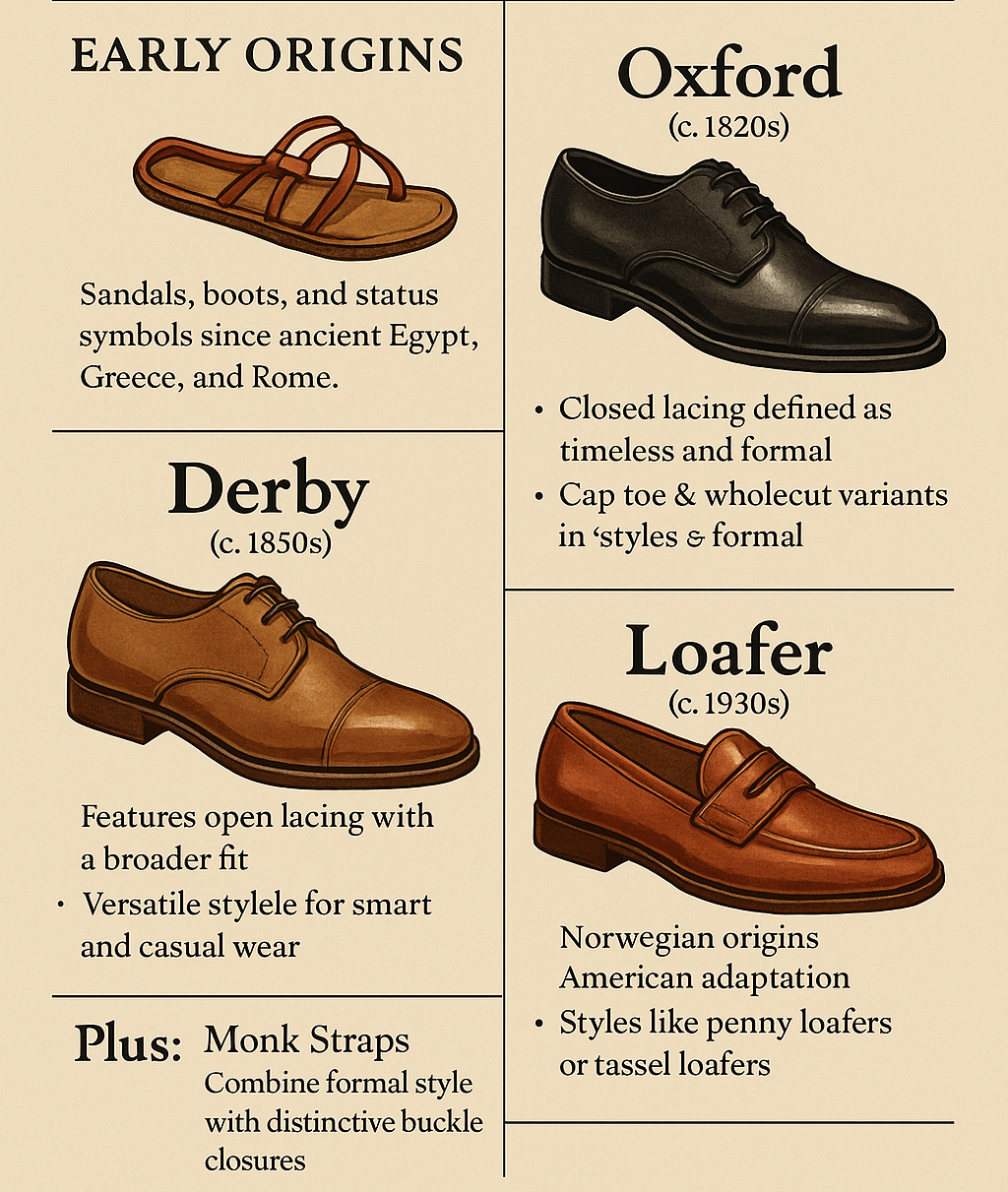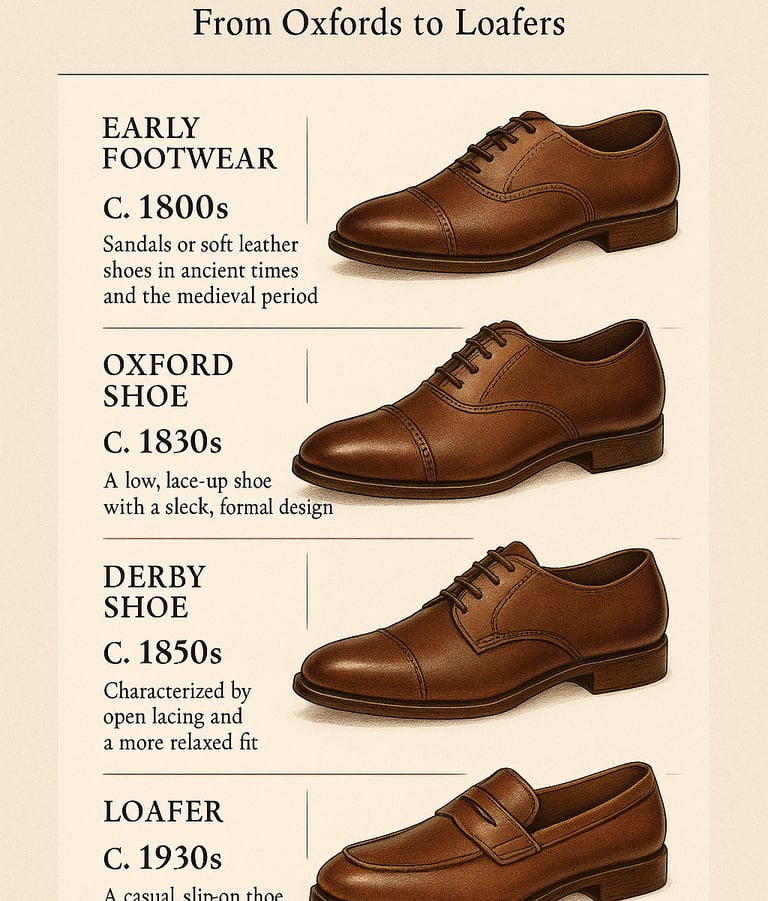he History of Men’s Dress Shoes: From Oxfords to Loafers
The History of Men’s Dress Shoes: From Oxfords to Loafers explores how classic footwear evolved through centuries of style, function, and cultural influence.
SHOES
7/16/20254 min read


The History of Men’s Dress Shoes: From Oxfords to Loafers
Meta Description: The History of Men’s Dress Shoes: From Oxfords to Loafers explores how classic footwear evolved through centuries of style, function, and cultural influence.
Introduction: Why Dress Shoes Matter in Men’s Fashion History
Dress shoes are more than just footwear—they're a reflection of social evolution, craftsmanship, and timeless elegance. From aristocratic leather boots to polished Oxfords and effortless loafers, men’s dress shoes tell the story of fashion, culture, and identity across generations.
This article traces the journey of iconic men’s dress shoes, helping you appreciate not just how to wear them—but where they come from.
Early Origins: Footwear in Classical and Medieval Times
Sandals, Boots, and Status Symbols in Ancient Civilizations
In Ancient Egypt, Greece, and Rome, sandals made from woven reeds or leather were common. In Rome, senators and citizens wore footwear with color-coded straps to indicate status.
Leather Shoemaking in Medieval Europe
During the medieval period, leather shoes were handmade, often pointy and soft-soled. Footwear became more specialized—boots for horseback riders, turnshoes for peasants, and embroidered slippers for the elite.
The Rise of Formal Footwear in the 17th–18th Centuries
The Buckled Shoe and Aristocratic Influence
The 1600s saw the emergence of low-heeled, leather shoes with large decorative buckles—worn by European aristocrats. These shoes symbolized wealth and refinement.
Heels for Men: French Courts and Fashion Statements
King Louis XIV popularized high-heeled shoes for men, with red soles signifying noble status. Men’s footwear became more flamboyant before giving way to sleeker styles.
The 19th Century: The Birth of Modern Dress Shoes
Introduction of Laced Shoes and the First Oxfords
Laced shoes started replacing buckles in the early 1800s. The Oxford shoe emerged from Oxford University students who rejected ankle-high boots for more comfortable, low-cut, laced shoes.
Transition from Function to Fashion
As the industrial revolution advanced, shoes shifted from purely functional to fashionable, with better leather production and new sewing techniques enabling more refined designs.
The Oxford Shoe: Timeless and Iconic
Origin at Oxford University
Originally known as the Oxonian, the Oxford became popular in the 1820s. Its defining feature—closed lacing—offered a cleaner, sleeker look ideal for formalwear.
Design Features and Variations
Cap Toe Oxford: Most formal; ideal for suits and black-tie.
Wholecut Oxford: Made from a single piece of leather; elegant and minimalist.
Wingtip Oxford (Brogue): Features decorative perforations; more casual, yet classic.
The Derby Shoe: A More Casual Cousin
Open Lacing and Broader Fit
Unlike the Oxford, the Derby (or Blucher) has open lacing, making it easier to fit wider feet and more versatile in casual settings.
When and How Derbies Became Popular
Originally used as hunting or sporting shoes, Derbies gained ground in the late 1800s and became staples for everyday and business-casual wear.
The Rise of Loafers: Easy Elegance
Norwegian Origins and American Adaptation
Loafers began as slip-on shoes inspired by Norwegian fisherman footwear in the 1930s. They were adopted by American preppy culture and evolved into dress-casual staples.
Penny Loafers, Tassel Loafers, and Horsebit Style
Penny Loafers: Named for the coin slot design; Ivy League favorite.
Tassel Loafers: Introduced in the 1950s; dressier and sleek.
Horsebit Loafers: Made iconic by Gucci; feature a metal buckle across the vamp.
Monk Straps and Other Dress Shoe Innovations
A Hybrid of Formal and Modern Styling
Monk straps combine the formality of Oxfords with a buckle closure, offering a distinctive look. They bridge the gap between traditional and contemporary dress styles.
Single vs Double Monk Strap History
Double monk straps gained popularity in the 2000s but trace their origins to monks in the 15th century, who needed sturdy, buckle-fastened shoes for monastic work and travel.
Cultural Influences on Men’s Dress Shoes
Jazz Age, Ivy League, and Hollywood Style
1920s–30s: Spats, two-tone shoes, and jazz influences.
1950s: Ivy League look made loafers mainstream.
1960s–70s: Platform shoes and mod boots entered mainstream via pop culture.
Global Adaptations and Regional Differences
British brands like Church’s emphasized tradition. Italian shoemakers like Santoni and Gucci introduced flair. American styles focused on functionality and mass appeal.
Dress Shoes in the 20th Century: Mass Production and Fashion Cycles
Post-War Manufacturing and Global Brands
Post-WWII, mass production made dress shoes more affordable. Brands like Allen Edmonds, Florsheim, and Johnston & Murphy rose to prominence.
1980s–2000s: Revival of Classics and Designer Takes
Classic silhouettes returned with premium twists. Designers like Tom Ford, Prada, and Yves Saint Laurent infused traditional shoes with runway energy.
21st Century Evolution: Comfort, Customization, and Versatility
Smart-Casual Crossovers and Hybrid Designs
Today’s dress shoes often feature rubber soles, memory foam, and sneaker-like interiors—blending form with function.
Sustainability and New Materials
Eco-conscious brands now craft shoes with recycled leather, plant-based soles, and ethical labor practices, adding modern values to timeless styles.
Style Guide: When to Wear Which Dress Shoe
Oxfords for Black Tie and Business Formal
Pair with:
Tuxedos
Dark suits
Formal occasions like weddings or high-end dinners
Loafers and Derbies for Business Casual
Perfect for:
Office environments
Semi-formal events
Smart-casual weekends
Dress Shoe Care Through the Ages
Traditional Polish, Cedar Trees, and Modern Maintenance Tools
To keep dress shoes looking their best:
Use shoe trees to maintain shape
Polish regularly with high-quality cream or wax
Rotate pairs to extend life
Protect from water and salt using sprays or conditioners
FAQs About Men’s Dress Shoe History and Style
Q1. What’s the most formal type of men’s dress shoe?
The Oxford—especially the black cap toe—is considered the most formal.
Q2. What’s the difference between Oxford and Derby shoes?
The lacing system: Oxfords have closed lacing, Derbies have open lacing.
Q3. Are loafers appropriate for formal wear?
Certain loafers (like black leather horsebit styles) can work for semi-formal events, but not for black tie.
Q4. How long should dress shoes last?
With proper care, a quality pair can last 10+ years—especially if resoled.
Q5. Are monk straps formal?
Yes. Single monk straps are often worn with suits, while double monks are slightly bolder but still sharp.
Q6. Can you wear dress shoes with jeans?
Yes—Derbies, loafers, and even monk straps can dress up denim smartly.
Conclusion: Stepping Through Time in Style
From the cobbled streets of Oxford to the boardrooms of today, men’s dress shoes have evolved—but never gone out of style. They’ve walked through centuries of change, yet remain a cornerstone of masculine elegance.
Understanding their history helps you appreciate not just the look—but the legacy—behind every polished step. So next time you slip on your Oxfords or loafers, remember: you’re walking in the footsteps of fashion history.

